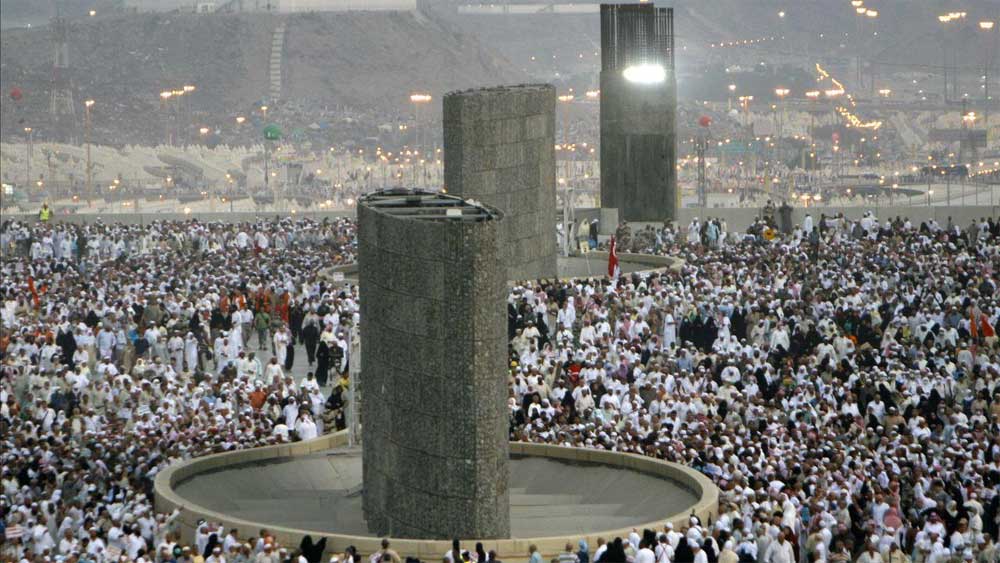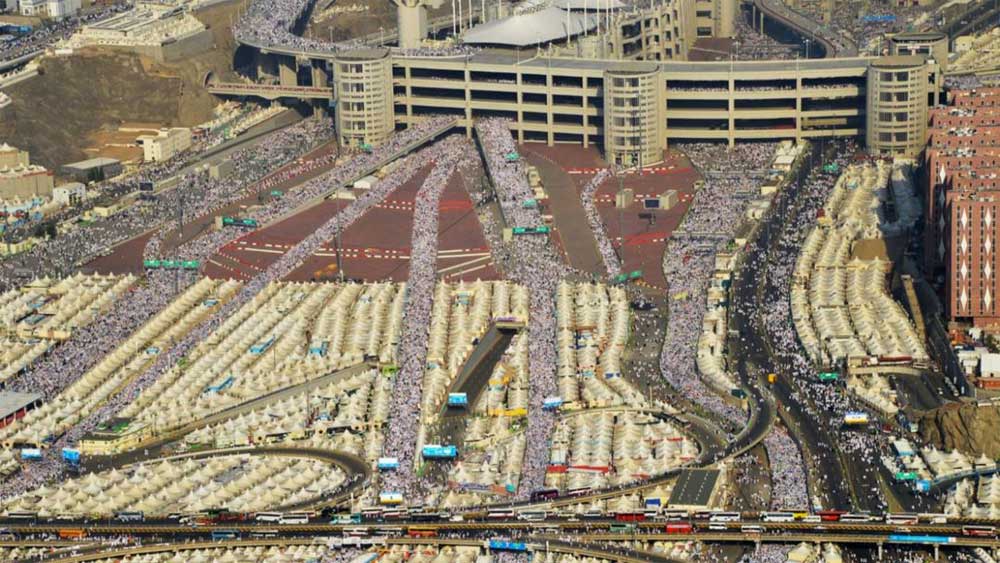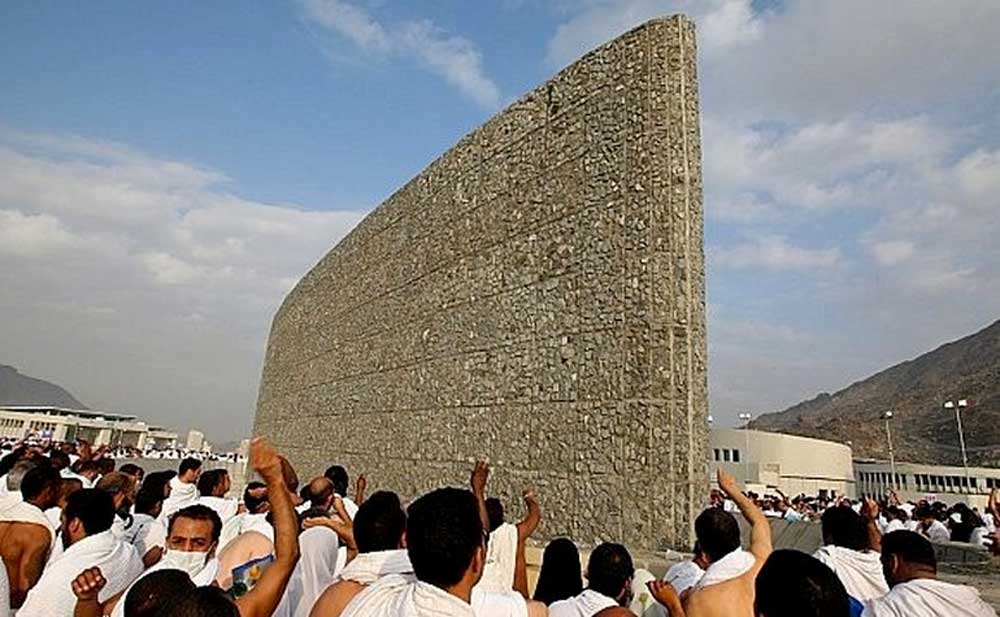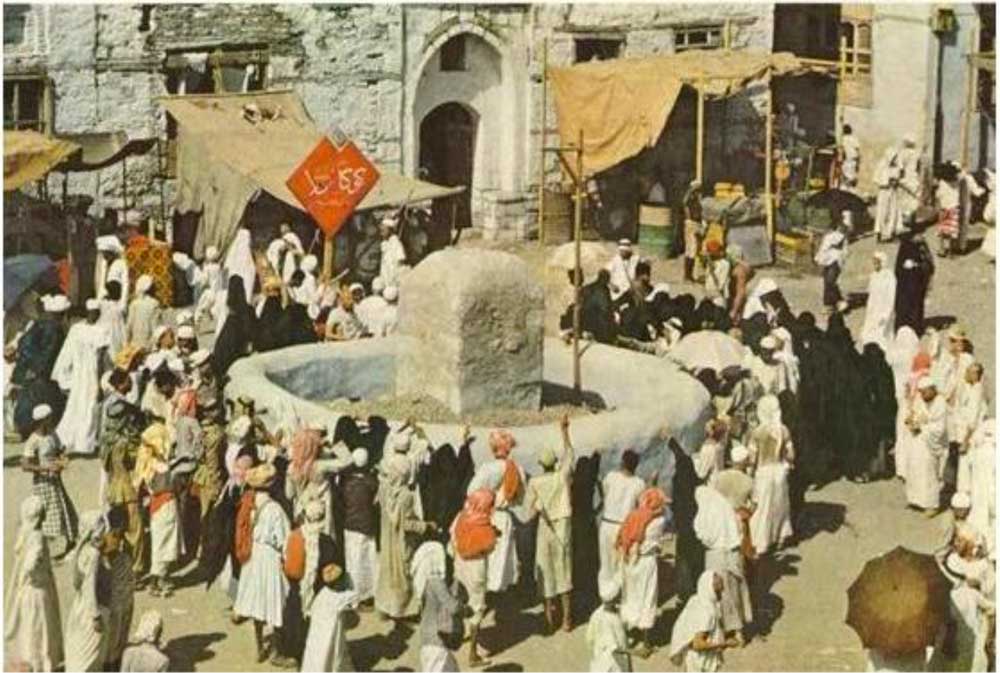The Jamarat

The Jamarat are three stone pillars which are pelted as a compulsory ritual of Hajj in emulation of the Prophet Ebrahim (upon him be peace). They represent the three locations where Ebrahim (upon him be peace) pelted the Shaitan (Satan) with stones when he tried to dissuade him from sacrificing his son Ismail (upon him be peace). The pillars are called ‘ Jamarat-al-Ula’ , ‘ Jamarat-al-Wusta’ and ‘ Jamarat-al-Aqaba’ .
- One of the purposes of the Hajj is to recall, while in Mina, how a 94 year old father brought his eight year old son here for sacrifice. Ebrahim (upon him be peace) had first left his wife and newborn son, Ismail (upon him be peace) in the desert upon Allah’ s command. Then while returning after eight years to them he saw a dream wherein a man told him that Allah (Glorified and Exalted is He) wanted him to sacrifice his son. He saw the same dream for three consecutive nights and as he was a Prophet, his dreams were a form of Wahy (Divine Instruction). He realised that Allah (Glorified and Exalted is He) wanted him to sacrifice his son for whom his heart was overfilled with love and emotions. He went to his wife and asked her to dress up Ismail (upon him be peace). Ismail (upon him be peace) was overjoyed that his father had come after such a long time and was now taking him out for a walk. When Hajra (upon her be peace) asked, “ Where are you taking him?” He replied, “ To meet a friend.”
- They then reached Mina. Here Ebrahim (upon him be peace) asked his son that your father has seen such a dream, what is your opinion about it? The reason for asking was not to ask his opinion in deciding whether to go ahead with the command or not. It was to assess whether his son will allow him to follow the command freely or will he have to forcibly carry out this order. In other words, he asked this to test the intensity of love for Allah in his son’ s heart. The son replied, “ My father, obey the command given by Allah. You will, Insha’ Allah, find me steadfast. Give my shirt to my mother as it will be a source of comfort for her and wrap me in your own shirt. Put me face down so you can’ t see my face, lest you hesitate in carrying out my slaughter.”

- The skies and the earth witnessed that Ebrahim (upon him be peace) tied his son and laid him down. Now this was very unacceptable to Shaitan so he first went to Hajra (upon her be peace) and asked her, “ Do you know where Ebrahim has taken your son?” She replied,” To meet a friend.” He said, “ By meet a friend he meant to meet Allah. He is going to sacrifice him!” She said, “ How can a father sacrifice his son?” By mistake, Shaitan uttered, “ It is Allah’ s command.” On hearing this Hajra (upon her be peace) replied, “ If this is Allah’ s command, then even a hundred Ismails can be sacrificed in this way.”
- Then he went to distract Ebrahim (upon him be peace). When he appeared to him at the first Jamarat, Jibraeel (upon him be peace) said to Ebrahim (upon him be peace): “ Pelt him!” so Ebrahim (upon him be peace) threw seven stones at him and he disappeared from him. Then he appeared to him at the second Jamarat. Jibraeel (upon him be peace) said to him: “ Pelt him!” so he pelted him with seven stones and he disappeared from him. Then he appeared to him at the third Jamarat. Jibraeel (upon him be peace) again instructed him: “ Pelt him!” so he pelted him again with seven small stones and Shaitan withdrew from him. This action is imitated by all Hujjaj, symbolising one’ s acknowledgement that Shaitan is one’ s enemy and ought to be repulsed.

- Ebrahim (upon him be peace) then laid Ismail (upon him be peace) down and put his knee on his neck so that he may not move. Then he faced the sky and called to Almighty Allah that, “ Oh Allah! If you did not like the presence of love for Ismail in my heart, I seek your forgiveness.” Then he proclaimed Allah’ s name and placed the knife on Ismail’ s (upon him be peace) throat. He would rub the knife but it wouldn’ t cut, Allah (Glorified and Exalted is He) had taken the quality of cutting away from the knife.
- Allah (Glorified and Exalted is He) was pleased with the sincerity of Ebrahim (upon him be peace) and sent a white, big-eyed sheep with horns in replacement of Ismail (upon him be peace) which Ebrahim (upon him be peace) sacrificed instead. This is the basis for the offering of sacrifice animals by the Hujjaj and by all other Muslims at the time of Eid-ul-Adha.

- Note that the views of the Jews and Christians greatly differ from Muslims with regards to who the sacrificial son was and where this incident took place. In order to enhance their prestige and honour they have attributed the sacrificial son to Ishaq (upon him be peace) who is the forefather of the Jews and Christians rather than Ismail (upon him be peace) who is the forefather of the Muslims. They have also placed the setting to be in Jerusalem rather than Mina. It is clear, by looking at Biblical scriptural evidence that the sacrificial son could only have been Ismail (upon him be peace). For example, in Genesis 22:2 Abraham is commanded to take his only son for sacrifice. As Ismail (upon him be peace) was 13 years older than Ishaq (upon him be peace) and both were alive at the time of their father’ s death, logically Ishaq (upon him be peace) could never be his only son.

Conditions while stoning the Jamarat
Certain conditions have to be observed while stoning the Jamarat:
1- Having the intention of closeness to Allah, and it is enough to have the intention in the heart that he/she has the intention of throwing seven pebbles to the Jamarah for obeying Allah and performing rituals of Hajj and it is not necessary to say this intention by words.
2- The pilgrim should use seven pebbles (not being very large and not being very small, it is enough that each of them to be in size of a finger nail).
3- Pebbles should be hurled one by one and throwing two pebbles together is considered is throwing only one.1
4- Pebbles should strike Jamarah and if there is a doubt in this matter, it is not enough and the act should be performed again.
5- Pebbles should be hurled not being placed in the place of Jamarah and it is not enough that pebbles strike Jamarah with assistance of other person or thing (for example if a pilgrim throws a pebble and this pebble strikes Jamarah by assistance of other pebble which has been hurled by another person, then this is not enough).
6- The time for performing the throwing of the pebbles is from sunrise until sunset of the day of the Eid, but as we said before “ women” and “ old men” and those who are afraid of the congestion of the crowd can perform Rami al-Jamarah at the night of the Eid.
7- Pebbles have three conditions:
“ First” , they should be stone, not clod or clay or anything else.
“ Second” , they should be collected from “ Haram” (attention that all of Mash' ar al-Haram and Mina are placed in Haram but Arafat is out of Haram), but it is better to collect the pebbles from Mash' ar al-Haram in the night of the Eid, also collecting from “ Mina” and “ Mecca” has no problem.
“ Third” , pebbles should be untouched; it means that nobody or even the pilgrim himself/herself had not used them for Rami al-Jamarat before.
Therefore, pebbles which are fallen around Jamarah and have been used cannot be used for Rami al-Jamarat. But if the pilgrim sees pebbles in other than that place and doubts that if these have been used or not, he/she can use them.
It should be considered that 49 pebbles are needed for three days (and if the pilgrim has to stay the thirteenth day then he/she needs 70 pebbles) that is better to collect them in the night of the Eid from Mash' ar and bring them in a bag with himself/herself, but it is better to have some more pebbles because it is possible that some of them may not strike the Jamarah.
Additional Considerations:
- It is an obligatory precaution not to collect the pebbles from mosques in there.
- Rami al-Jamarah can be performed ride or afoot, with the right or the left hand, also there is no specific method for throwing them and having ablution is not a condition, although it is better to perform Rami al-Jamarah afoot with ablution and with the right hand, and in that state it is better to praise and pray to Allah.
- Performing Rami is not permitted in the night, except for women and ill persons and those who are afraid of the congestion of crowd in the day, or people who are busy in days managing and arranging the tasks of Hajjis in caravans (there is no difference in performing Rami in the night before or after).
- Rami al-Jamarah al-Aqaba and other Jamarat can be performed from any side, although it is famous that it is Mustahab to stand back to Qibla and facing Jamarah when performing Rami al-Jamarah al-Aqaba, but it is Mustahab to face the Qibla in performing Rami of other Jamarat.
- Whenever a pilgrim doubts about the number of pebbles which have been hurled, he/she should take the lesser number and perform the rest, and if he/she is sure about performing less than seven, he/she can perform the rest if the sequence has not been past and if it has been passed it is precaution to perform the rest and then perform it again by other seven pebbles.
- Whenever a person renounces Rami al-Jamarah because of forgetfulness or ignorance about the matter, it is necessary to perform that whenever he/she remembers or informed about the matter until the thirteenth day, and it is better to perform the Ghazaa of the previous day before the noon and the duty of that day in afternoon; but it has no problem to perform them both in one time (first the Ghazaa of the previous day and then the duty of that same day).
- If a pilgrim finds out that he/she had not performed Rami al-Jamarah after returning to Mecca from Mina, he/she should return to Mina and perform that, and if the thirteenth day has passed he/she should perform that in the next year in the same days or if it is not possible, he/she should take a proxy for performing that.
- If a person renounces Rami al-Jamarah deliberately, his/her Hajj is not invalidated but he/she should act according to the previous point.
- The sequence of Jamarat should be observed in the eleventh and twelfth days which Rami of all three Jamarat is obligatory; it means that the pilgrim should perform Rami first on the place of “ Jamarah al-Uula” , then “ Jamarah al-Wusta” and after that the “ Jamarah al-Aqaba” which is the last Jamarah (this is for the eleventh and the twelfth day; but in the tenth day which is the day of the Eid only Rami al-Jamarah al-Aqaba is performed).
- Whenever sequence has not been observed in Rami al-Jamarat, the pilgrim should return and perform it in the way that sequence is observed, but if he/she has hurled four pebbles or more to each Jamarah, he/she returns and performs the rest sequentially, and if he/she has not hurled four pebbles, then he/she should return and perform from the beginning and throw seven pebbles, and if he/she has missed three pebbles or less from one of Jamarat, he/she should complete only that Jamarah and there is nothing else obligatory for him/her in this matter.
- If the pilgrim has not observed the sequence deliberately, it is obligatory precaution to return and perform that from the beginning and there is no difference between four pebbles or less.
- It is obligatory to observe the “ sequence without interruption” it means that the pilgrim should hurl the pebbles sequentially and with a little pause between them to the place of Jamarah, but as we said before, if a pilgrim has hurled four pebbles or more to the Jamarah sequentially and has renounced the rest because of forgetfulness or ignorance about the matter, then he/she can hurl the rest in another time although the sequence has been passed.
- As it has been mentioned before those who cannot perform Rami in the day because of an excuse should perform it in the night, and if they are incapable of performing it in the night or there is fear of a danger or harm, they should take a proxy to perform Rami in behalf of them in the day.
- Today, upper levels have been constructed for Jamarat, and it seems that performing Rami from the upper level also suffices and it is enough when pebbles are hurled into the holes around the Jamarah and falls on the ground.